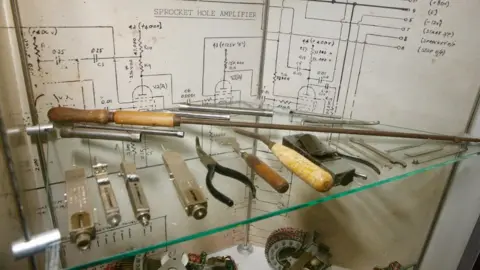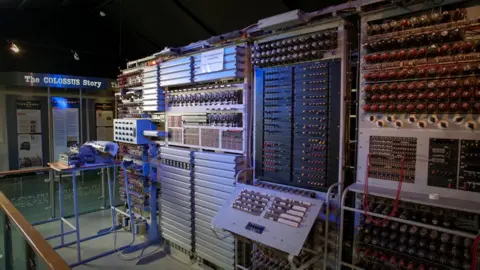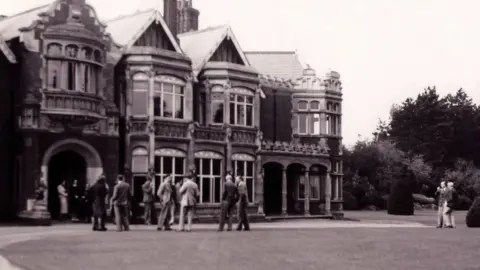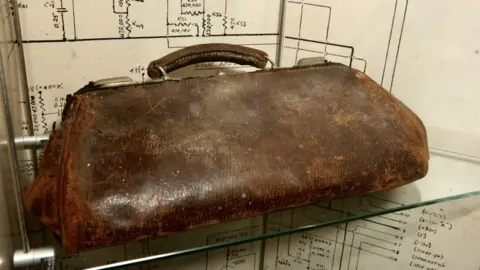WW2 Colossus tools donated by Bletchley Park engineer's family
 Robert Dowell
Robert DowellThe tools of an engineer, who maintained Britain's World War Two code-breaking Colossus computers, have been donated to a museum by his family.
Henry Cane, known as John, who died in March 2017, was in a team that kept the computers running at the Bletchley Park intelligence centre.
Experts think their work shortened the 1939-45 war by two years.
His 1940s bag and 20 tools have been given to the National Museum of Computing at Bletchley.
 The National Museum of Computing
The National Museum of ComputingThey have gone on display alongside a working rebuild of the one of the machines.
'Very precious'
The Colossus, the world's first programmable computer, was designed by a team led by Tommy Flowers at the General Post Office in London in late 1943.
It was programmed to run algorithms used to decipher messages sent among German High Command, who had encrypted them using their Lorenz cipher system.
After moving Colossus to Bletchley, in rural Buckinghamshire, the first Lorenz message was cracked on 5 February 1944, reducing the time it took to break the cipher from weeks to hours.

Bletchley Park
 BBC/Arrow Media/Bletchley Park
BBC/Arrow Media/Bletchley Park- Bletchley Park was the wartime home of the Government Code & Cypher School which broke the German Enigma and Lorenz codes
- The mansion dates from the 19th Century but the intelligence centre was rapidly assembled with mainly wooden structures in 1939 where mathematicians including Alan Turing (as played by Benedict Cumberbatch in the movie The Imitation Game) and Bill Tutte worked
- It was not until wartime information was declassified in the mid-1970s that the story of the work done at the centre began to emerge
- The buildings had fallen into disrepair but with the help of a £4.6m Heritage Lottery Fund (HLF) grant, awarded in October 2011, the Bletchley Park Trust charity restored it and turned it into an interactive museum
- The National Museum of Computing, which traces the development of computing from Colossus through to the modern-day, is located in Block H on the Bletchley Park estate, but is a separate charity

Andrew Herbert, chairman of the museum, said: "The Colossus machines were instrumental in shortening the war by an estimated two years, thereby saving countless thousands of lives."
 Robert Dowell
Robert DowellMr Cane helped maintain the machines at Bletchley Park from February 1944 until the end of the war in 1945.
After the war, two of the 10 Colossus machines ended up at the government's new GCHQ in Cheltenham, Gloucestershire. The other eight were dismantled.
Decades on, a Colossus was rebuilt for display at the museum which was founded to help preserve the UK's wartime computers, which are regarded as forerunners of the modern computer industry.
The museum's chief engineer, Phil Hayes, said: "I use tools like John Cane's almost every day to keep the rebuild running, but these originals are very precious.
"They became critical to the war effort because Tommy Flowers, a telephone engineer by training, built Colossus mostly with telecommunications components - that was the technology available to him."
